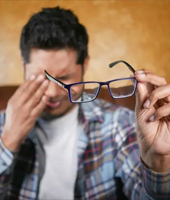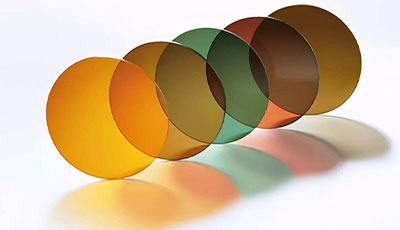How to Measure Your Pupillary Distance (PD)
You'll need to know your PD if you want to order new glasses online from Basames. Don't worry if your glasses prescription doesn't include your PD, we can show you how to measure it by yourself.
What Is Pupillary Distance?
PUPILLARY DISTANCE (PD) measures the distance between the centers of your pupils. This measurement is used to determine where you look through the lens of your glasses and should be as accurate as possible.
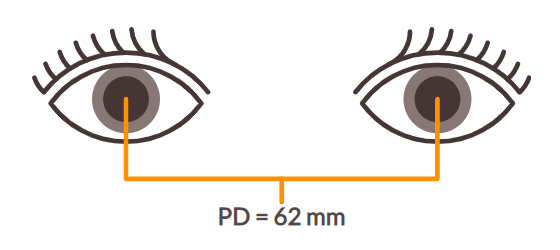
The average adult's PD is between 54-74 mm; kids' are between 43-58 mm.
If you don't have your PD from your eye doctor, you can measure it yourself with the help of a friend, or you can measure it yourself with our step-by-step guide below.
Why Is It Important?
Every set of prescription lenses has an “optical center,” which is determined by pupillary distance. Pupillary distance is used to determine where you look through the lens of your glasses and should be as accurate as possible.

Measure The Distance
Your prescription may tell you your PD. But if the PD is not available, use your friend or a mirror to help you figure it out. Necessary tools: millimeter ruler and mirror.
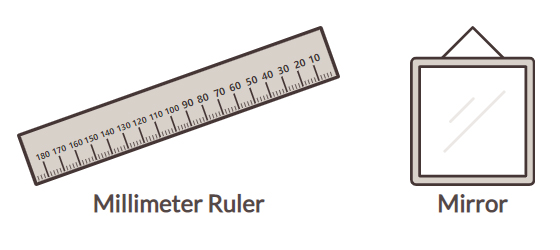
Measuring Your Own PD
1. Stand 8 in. away from the mirror.
2. With your face straight, hold the ruler against your brow.
3. Close your right eye and align the ruler's zero to the center of your left pupil.
4. While looking straight, close your left eye and open your right eye.
5. Read the mm line that lines up with the center of your right pupil. This number is your PD.
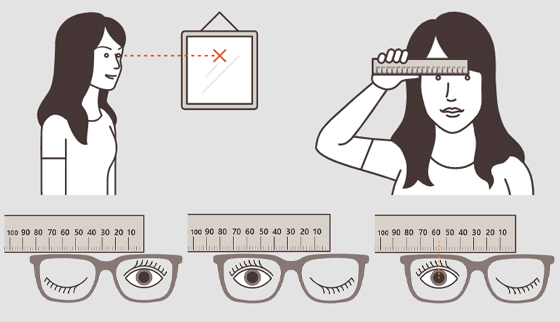
A Few Things to Note
Measure your PD 3-4 times to ensure it's accurate and consistent.
Range of Adult PD: 54-74 mm.
Range of Child PD: 43-58 mm.
Having a Friend Measure Your PD
If a friend is measuring your PD, keep both eyes open and have your friend put the zero on the millimeter ruler over the center of one pupil, then measure the distance to the center of the other pupil.

Tips When a Friend is Measuring
Have them crouch/sit while you stand so they are out of your field of vision.
Look above his/her head at something approximately 10-20 ft away.
Keep your eyes as still as possible.
Do not look at the person measuring!
What Is Single Vs Dual PD?
SINGLE PD is the pupillary distance between the center of one pupil to the other, which can be a distance PD or near PD. Distance PD can be used to order any type of prescription glasses except reading glasses. Read below to learn how to calculate near PD for reading glasses.

Dual PD, or monocular PD, consists of two numbers and is the distance between the centers of each pupil to the bridge of the nose. Dual PD is usually written in the following notation: 32/30. The first number is always the right eye (OD) measurement, and the second number is the left eye (OS).
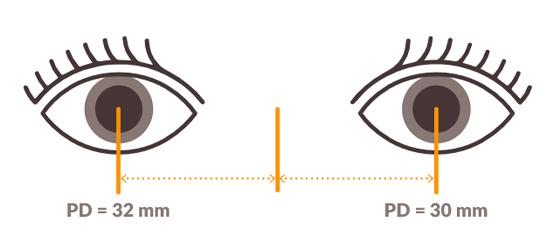
How Do You Calculate Near PD For Reading Glasses?
You can calculate Near PD for reading glasses by subtracting 3mm from your distance PD. For example, if your distance PD is 63mm, then your near PD is 60mm.
If you are using Dual PD to calculate near PD, then subtract 1.5mm from each eye's measurement. For example, if your dual PD is 33/31mm then your near PD would be 31.5/29.5mm.

Frequently Asked Questions
What is ‘pupillary distance'?
You usually can't find your PD number written on your eyeglasses. The numbers on the inside of the temple arms of some frames show the measurements for the frame itself. Your PD number should be written on your eyeglass prescription in the PD section.
Can I find my PD on my glasses?
There are various mobile apps that can measure your PD using your phone's camera. You can find EyeBuyDirect's PD measurement tool by pressing the ‘i' button in the PD section when entering your prescription.
Does my PD have to be exact?
Your PD should be exact. If your lenses aren't centered correctly, they can cause discomfort and eye strain. A small margin of error might not cause problems, but it's better to be as accurate as possible.
Where is my PD on my prescription?
Your PD number will be in the ‘PD' or ‘pupillary distance' section of your eyeglass prescription. This is often separate from the ‘grid' section of your prescription - where the doctor writes out the main prescription information.
What happens if my pupillary distance measurement is off?
If your eyeglass lenses aren't properly centered based on your PD number they can cause dizziness, headaches or blurred vision. Your vision is centered on a small section of the lenses, so a PD number is needed to shape the lenses to perfectly suit your needs.
Does PD affect frame size?
Your PD has no effect on the size of your eyeglass frame. The PD number influences the shape of your lenses, but not the frame.
Does PD change over time?
A person's pupillary distance will change when they are young as they are still physically growing. Once we reach maturity and stop growing, our pupillary distance will change very little, if at all.
Is PD important for single vision glasses?
The PD number indicates exactly which part of the lens you look through; therefore, the PD number is important for every type of prescription lens, including single vision glasses.
What is the difference between ‘single' and ‘dual' pupillary distance?
A ‘single' pupillary distance number is the distance in millimeters between one eye's pupil to the other eye's pupil. A ‘dual' pupillary distance number is the distance in millimeters from each eye's pupil to the center of your nose. A single PD will be just one number, while a dual PD will have a number for each eye, marked ‘right' and ‘left'. (Some prescriptions may have ‘OD' for the ‘right' eye, and ‘OS' for ‘left' eye.)




